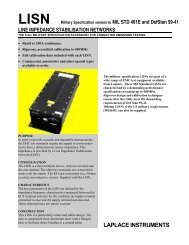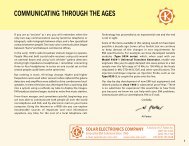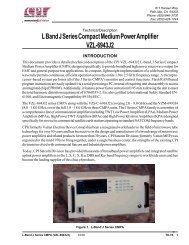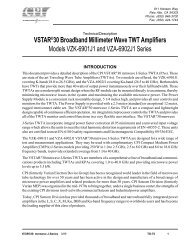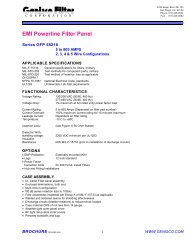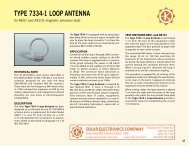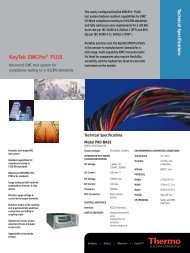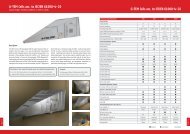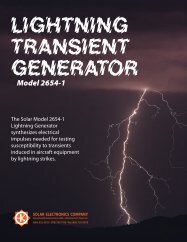Model 9354-1 Universal Transient Generator
Model 9354-1 Universal Transient Generator
Model 9354-1 Universal Transient Generator
Create successful ePaper yourself
Turn your PDF publications into a flip-book with our unique Google optimized e-Paper software.
MODEL <strong>9354</strong>-1 UNIVERSAL TRANSIENT GENERATORfor susceptibility tests MIL-STD461C/D/E, DO-160C/D and other specificationsAPPLICATIONThe <strong>Model</strong> <strong>9354</strong>-1 <strong>Universal</strong> <strong>Transient</strong><strong>Generator</strong> was especially designed for theperformance of a variety of pulse susceptibilitytests on subsystems and/or equipment, inaccordance with MIL-STD-461D and E, methodCS116; RTCA DO160D, section 22; MIL-STD-461C,methods CS10 and CS11.Through the use of many Solar accessories,including various reactive networks and couplingdevices, as well as other commercially availableitems such as loop antennas, parallel plates,and TEM cells, the generated output may bemodified and applied to other specifications.(Contact Solar customer service for details.)DESCRIPTION<strong>Model</strong> <strong>9354</strong>-1 <strong>Universal</strong> <strong>Transient</strong> <strong>Generator</strong>provides nine selectable waveforms, includingsix damped sinusoidal pulses (10 KHz, 100 KHz,1 MHz, 10 MHz, 30 MHz, and 100 MHz) andthree double exponential pulses (6.4 S, 70 Sand 500 S).Auto pulsing of the sinusoidal repetition rateis internally adjusted from 0.5 to 1.0 pulse persecond. A front panel-mounted push button canbe used to manually trigger single pulses. Thepeak amplitude of the selected output pulse isadjustable as a percentage of the charge voltage.The six damped sinusoidal waveforms weredesigned to meet the requirements ofMIL-STD-461D and E, method CS116, whenapplied in accordance with the test method ofMIL-STD-462D. Continuous tunable frequenciescan be obtained by the use of the optionalvariable frequency modules.These same waveforms are applicable to therequirements of MIL-STD-461C, methods CS10and CS11, when applied in accordance with thetest method of MIL-STD-462, Notice 5.The 1MHz and 10 MHz damped sinusoidalwaveforms have been extended to a peak opencircuit voltage of 3200 volts and a calculatedshort circuit current of 128 amperes to meetthe requirements of RTCA DO-160D, Section 22,Table 22-2, waveform 3.The three double exponential pulses weredesigned to meet the requirements of RTCADO-160D, Section 22, Tables 22-2 and 22-3.Table 1 lists the test level that can be achievedfrom the <strong>Model</strong> <strong>9354</strong>-1.FEATURES■ Panel-mounted digital voltmeter. Monitors theadjusted open circuit discharge voltage.■ Pulse rates up to two pulses per secondmaximum (factory adjusted).■ Single pulse feature enables controlledisolation of transient effects.■ Output voltage adjustable from 0.1% to 100%of selected discharge voltage.Table 1: DO-160D Test Levels possiblefrom <strong>Model</strong> <strong>9354</strong>-1Waveform Pin Injection Cable BundleInjection1 (70 S) no requirement level 1- 42 (6.4 S) no requirement level 1 - 43 (1MHz & level 1 - 5 level 1 - 410 MHz)4 (70 S) level 1 - 5 level 1 - 45B (500 S) level 1 - 4 level 1 - 39
MODEL <strong>9354</strong>-1 UNIVERSAL TRANSIENT GENERATORAVAILABLE ACCESSORIESVariable and Step Frequency Modules. Providestunable frequencies for injection of dampedsinusoidal wave forms from 10 KHz to 100 MHzwhen used with <strong>Model</strong> <strong>9354</strong>-1. Five individualmodules waveforms cover the entire frequencyrange required by MIL-STD-461D. Detailedinformation provided on separate data sheet.Type 9335-2 <strong>Universal</strong> Coupling Device. Aninductive injection device that provides voltageand current transfer of 1:1, 1:1.5 and 3:1 voltagestep-up (current step-down) as well as 2:1 voltagestep-down (current step-up). For maximum powertransfer, these ratios are selected by connectingto one of the four BNC connectors. This device,through its various connector ports, provides abetter impedance match or power transfer, higheropen circuit voltages, or higher short circuitcurrents. Useable for cable current injection from10KHz to 10 MHz. Detailed information providedon separate data sheet.Type 9719-1N Injection Probe. Provides therequired current leveles of MIL-STD-461D and E,method CS116 throughout the entire frequencyrange of 10 KHz to 100 MHz.Type 9357-1 Calibration Fixture. Calibrationfixture provides a 50 ohm characteristicimpedance based on the dimensions of theType 9335-2 <strong>Universal</strong> Coupling Deviceand Type 9719-1N Injection Probe. The fixturemaintains a low standing wave ratio from 10 KHzto 100 MHz in a 50 ohm circuit.Type 9142-1N Injection Probe. Used to injectcurrent on cables from 1 MHz to 100 MHz.Type 9125-1 Calibration Fixture. Calibrationfixture for use with Type 9142-1N InjectionProbe.Type 9123-1N Current Probe. Used to monitorinjected pulses. Frequency range from 10 KHz to500 MHz.Type 9410-1 50/50 and Type 9454-1600/50 High Voltage Attenuators. Provides40 dB attenuation from 10 KHz to 100 MHz.Protects oscilloscope from high voltage damagewhen verifying the output pulses of the<strong>Model</strong> <strong>9354</strong>-1. The Type 9454-1 provides a highimpedance to the oscilloscope for makingmeasurements of open circuit output pulses.Type 6220-4 High Voltage Audio IsolationTransformer. When connected in series with thepower lead under test, provides twice the opencircuit voltage or twice the short circuit currentfor the 10 KHz and 100 MHz damped sinusoidwaves and the 6.4 S and 70 S doubleexponential pulses. Capable of handling up to4000 volts.VOLTS40200-20-400 S 200 S 400 S 600 S 800 SDAMPED SINUSOIDAL PULSE, (10 KHz KHz) INTO INTO AN AN OPEN OPEN CIRCUIT. CIRCUIT.Type 9616-1 Injection Clamp. Provides couplingfor high voltage pulses produced by the <strong>Model</strong><strong>9354</strong>-1. Meets the inductive indirect injectiondevice requirement of MIL-STD-462, notice 5,method CS10 and CS11. Enables injection of 70S double exponential pulses without need fordirect connection.SPECIFICATIONSDAMPED SINUSOID PULSES(NOTE: MEASUREMENT OF SHORT CIRCUIT CUR-RENTS ARE LIMITED BY THE X L OF THE CIRCUIT.ALL VALUES ARE CALCULATED.)10 KHzOpen Circuit Voltage . . . . . . . . . . . . . . . . . . . . . .30 V.Calculated Short Circuit Current . . . . . . . . .120 A.Source Impedance . . . . . . . . . . . . . . . . . . . . .
MODEL <strong>9354</strong>-1 UNIVERSAL TRANSIENT GENERATORDOUBLE EXPONENTIAL PULSES(NOTE: MEASUREMENT OF SHORT CIRCUIT CUR-RENTS ARE LIMITED BY THE X L OF THE CIRCUIT.ALL VALUES ARE CALCULATED.)6.4 SRise Time . . . . . . . . . . . . . . . . . . . . . . . . . . . . . .100 nS.Open Circuit Voltage . . . . . . . . . . . . . . . . . . . .1600 V.Calculated Short Circuit Current . . . . . . . . .800 A.Source Impedance . . . . . . . . . . . . . . . . . . . . . .



